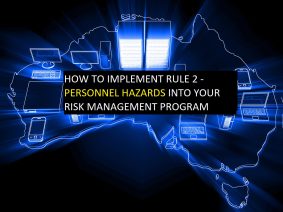Preemployment ‘Best Practice Guide’ for Social Media Screening.
A digital footprint is the unique pattern of electronic transactions made by an individual’s publicly accessible online presence. An assessment of an individual’s digital footprint can provide insight into their life, interactions and personal views. This information may identify behaviours of concern or provide further assurance that a candidate has provided a full and truthful account of information relevant to the assessment of their integrity.
As more and more people are living more and more of their lives on the internet, when it comes to pre-employment screening practice, one must navigate carefully. Hidden dangers, potential biases, and legal traps are arguments against even googling your shortlisted candidate’s name. Yet the tension to protect the employer’s brand, workplace safety and business reputation is strong and not doing it could place your quality recruitment into jeopardy. It would be career suicide to hire (or recommend) a known menace for a position, who failed a pub test after a google search on the person’s name.
This is an emerging field of practice. Think about these questions:
- Which search engines should I use?
- How many pages should I go through looking for a match?
- Who do I search (should I search family members, too)?
- What am I specifically searching or looking for after correctly identifying the candidate?
- What constitutes a red flag? Orange flag?
- Who defines what red looks like?
- How dodgy is dodgy?
- What constitutes an explicit photo?
- If the employer’s firewall places restrictions on investigating certain websites, can you just ‘fill in the gap’ about what might actually be there?
- What about false positives? How can you be sure, either way?
- What about a fake profiles under the candidate’s name?
- What about deleted posts?
- What about accessing information they have contributed to in private forums or groups?
- Should it be a one-time search or an ongoing one?
- Can you or should you share your results with the Candidate and ask for explanations?
- How do you judge, assess, adjudicate fairly and without discrimination?
- Should you hire a third party to do it?
The Australian Government has developed a digital footprint check framework to establish procedures for conducting these types of preemployment checks with suitability of personnel in mind.
Part 1: Open search check
An open search engine enables a wide screening of online data that may provide information on a clearance subject not captured in other security vetting checks. Check the candidate’s details within an open search engine to screen for any publicly accessible information relating to the candidate that is relevant to establishing their integrity and assessing their suitability, including: content generated by or attributable to the candidate, financial, professional and personal interests, key associates or influences, legal or administrative proceedings, media relating to candidate, any other data relevant to the candidate’s integrity.
Search terms:
- candidate’s full name
- candidate’s email address(es)
- account names, aliases or handles provided by the clearance subject (for large volume search returns it may be necessary to limit the search to a geographical location).
Time:
Relevant background check period 5 years, 10 years or to age 16. For large volume search returns it may be necessary to sample relevant returns.
Search engines:
any or a number of open search engine (eg Google, Bing, Internet Archive).
Part 2: Social media check
Online social media relating to the candidate can provide information about their online behaviour and social networks. Screen social media accounts and pages relating to the candidate for any publicly accessible information that is relevant to establishing their integrity and assessing their suitability, including:
- posted content
- ‘shared’ and ‘liked’ content (this should be viewed with caution, however, may be useful if consistent with other information known about, or posts made by, the candidate)
- participation in online communities and interest groups
- pages or accounts followed
- networking and interactions with other online persons or accounts.
The extent of information that is publicly accessible will depend on the scale of the candidate’s media presence and the privacy settings they have set on each platform.
Search terms:
- candidate’s full name
- candidate’s email address(es), and
- account names, aliases or handles provided by the candidate (for large volume search returns it may be necessary to limit the search to a geographical location).
Time:
- relevant background check period 5 years, 10 years or back to age 16 (for large volume search returns it may be necessary to sample relevant returns).
Social media platforms:
- Facebook, Instagram, Twitter
- any platforms the candidate has disclosed in the recruitment process
- any platforms identified in the open search check (Part 1).
Online behaviour
Posts, photos and other online activities are all online behaviours. Some online behaviours may be indicators of concern that require further investigation or consideration in the background check process. Some examples of concerning online behaviours include:
- Indications of inappropriate use of alcohol or drugs.
- Engaging in criminal activity or deliberate rule violations.
- News article or a Media profile obtained through circumstances that may bring reputational harm.
- Attitudes favouring inappropriate disclosure of sensitive or otherwise confidential information, the misuse of information technology systems and/or wilfully contravening of rules or regulations governing the handling of sensitive information.
- Indications of poor reliability or trustworthiness such as flagrant dishonesty, consistent tardiness and absenteeism.
- Appearing susceptible to, or easily succumbs to, groupthink or other conformity pressures (such as situations where the candidate continues to support dialogue that becomes intolerant, discriminatory or otherwise cruel).
- Deliberate participation in or endorsement of ideological motivations that are anti-democratic, anti-rule of law or otherwise fundamentally undermine the rights of others to live in a free society.
- Indications of significant associations, activities or attitudes that draw into question the subject’s loyalty to Australia.
- Images or information indicating impulsive or ostentatious purchases that suggests poor financial management, or indications the candidate is living above and beyond their financial means.
It can be difficult to establish the context of some online behaviour. That is why it is recommended that any online activity that may call into question a candidate’s integrity be investigated further. This means identifying additional context such as the candidate following controversial pages for research interest rather than personal loyalty or posting comments that are difficult to interpret without knowledge of a community’s culture or influences. This additional context is usually helpful. Oftentimes, you will need to secure a one-on-one conversation with the candidate to be fully satisfied. This is also called procedural fairness and natural justice. However, this process takes a certain amount of skill, experience and objectivity to ensure that accusations of decision making being bias or discriminatory will be proven unfounded.
Keeping records of online information
Personal information (other than sensitive personal information about a third party to the candidate) should not be collected unless it is directly relevant to the candidate’s suitability assessment. It is recommended to comprehensively document the information obtained through the digital footprint check because of the changing nature of online information. Information must have a relevant adverse bearing on suitability indicators such as Honesty, Trustworthiness, Tolerance, Maturity, Loyalty. This include screenshots and direct links where possible.
We hope that this framework can assist you.
Conclusion:
Our experience tells us that if you choose to conduct these social media checks manually, you might feel overwhelmed with the amount of non-matching information that comes up and trying to isolate your candidate can be difficult. Then finding red flags is also labourious. Summed up: the manual process takes time. The good news is that one of the fastest parts of the process is discussing the flags with the candidate.
You might say “Let’s outsource the check. It will show due-diligence, provide some legal liability distance, offer objectivity and in-house bias will be held at bay”. However, commercial outsourcing companies usually do not ‘adjudicate’. Which means your Report will have adverse screenshots with no context. Someone will still need to investigate the context and analyse the information. It is sobering to know that 1 in 4 complaints to the Human Rights Commission is via unsuccessful shortlisted applicants who feel they have been discriminated against because of their criminal history. Without proper analysis, standardisation and adjudication, you may find yourself responding to unfair employment decisions relating to the digital footprint check.
Would you be interested in an automatic digital footprint check that does ALL of this hard work for you? The searching, the red flag identification, the candidate investigation interview, the risk review and analysis … as well as the adjudication recommendation for you?
We use and recommend an automated digital footprint check solution – contact us today to find out more.
Further reading:
Is Ignoring A Candidate’s Digital Footprint Negligent Hiring?
How to Increase the Quality of your Candidates by 70%
Original source: Personnel Suitability






